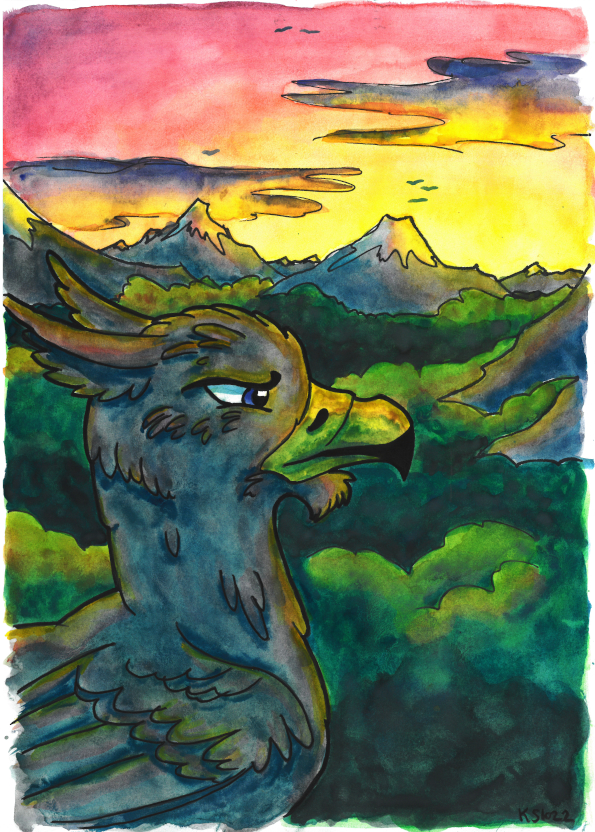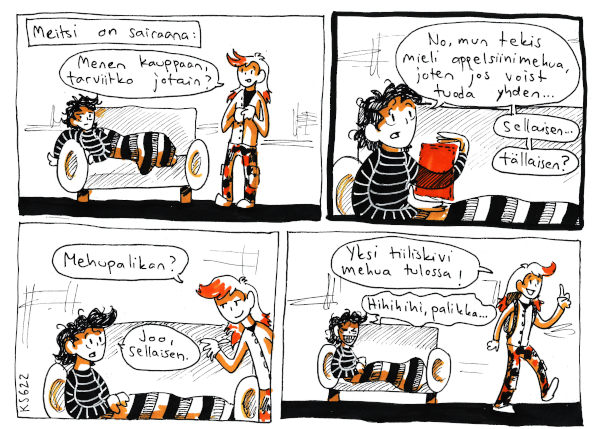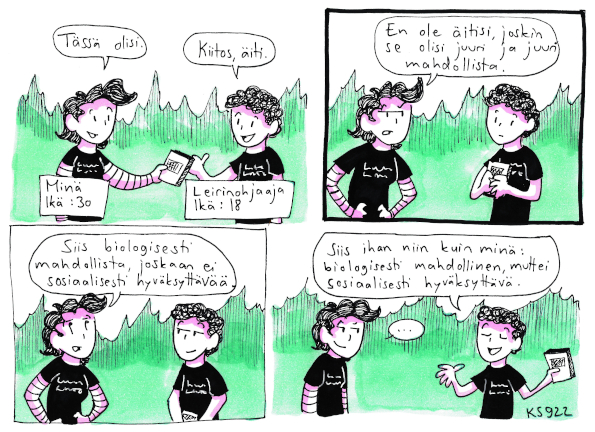CTID: TEXT WALLS
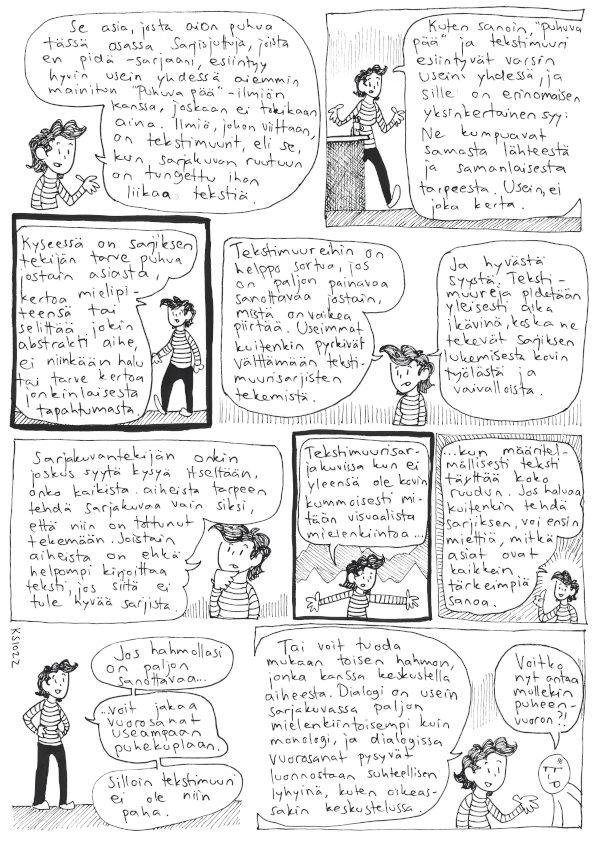
”The thing I’m going to talk about in this part of my series of Comic Things I Dislike often appears with the ’talking heads’ phenomenon mentioned earlier, though of course not always. What I’m referring to here is text walls which means that the panels are filled with way too much text.” //
”As I said, ’talking heads’ and text walls quite often appear together, and there is one very good reason for this. They come from the same place and same kind of need. Often, not every time.” //
”What I mean here is the comic maker’s need to talk about something, tell their opinion or explain some abstract concept, not so much the want or need to tell about something that has happened.” //
”One easily falls victim to a text wall if one has important things to say about something that is difficult to draw about. However, most comic creators try to avoid making text wall comics. And for a good reason, too. Text walls are mostly considered pretty boring as they make reading the comic painstaking and slow.” //
”Sometimes it is a good idea for a comic maker to ask themselves if it is necessary to make a comic about some topic just because they’re used to do so. Maybe it is better to just write about certain things if they don’t make good comics.” //
”Because text wall comics often aren’t visually that interesting…” //
”…as the text by definition fills most of the panel. If you still want to make that comic, think first about which things are the most important ones to say.” //
”If your character has plenty to say… you can divide their lines into more than one speech bubble. Then the text wall doesn’t look that bad.” //
”Or you can bring in another character with whom to discuss the topic. A dialogue is often much more interesting in comics than a monologue, and like in real life conversation, in a dialogue the lines naturally stay shorter.” ”Could you please let me talk here, too?”
Arkistot kuukauden mukaan: lokakuu 2022
SJEP: Puhuvat päät
CTID: TALKING HEADS
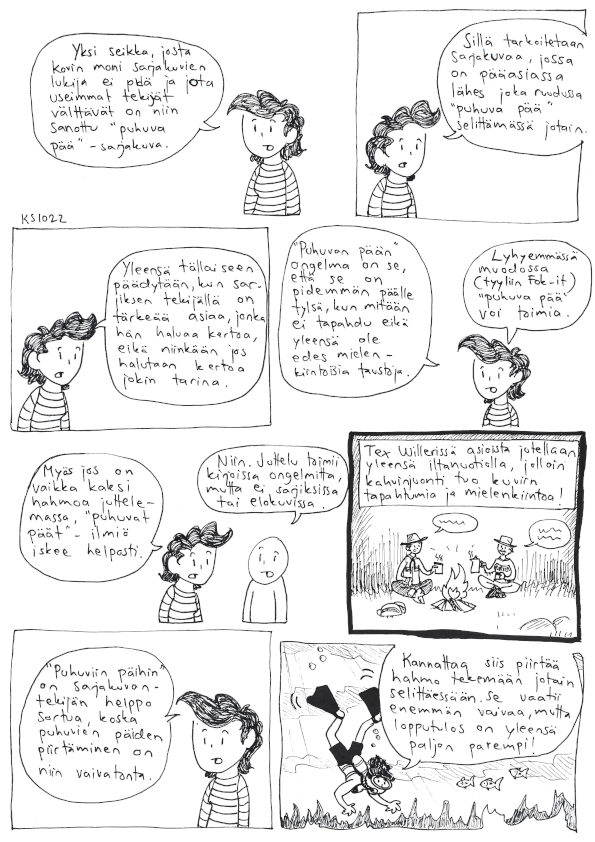
”One thing that many comic readers don’t like and most comic artists try to avoid is so-called ’talking heads’ comic.” //
”It means a comic in which in almost every panel there is a ’talking head’ explaining something.” //
”Mostly you end up with this when the comic maker has something important they want to say, not so much if they have a story to tell.”
”The problem with the ’talking head’ is that it get quickly boring as nothing happens and mostly the backgrounds aren’t that interesting, either. In shorter form, such as in Fok_it, the ’talking head may work.” //
”The ’talking head’ phenomenon easily happens also if you have two people discussing something.” ”Indeed. Conversations work without problems in books but not so easily in comics or movies.” //
In Tex Willer the characters mostly discuss by campfires where making coffee brings something visually interesting the the panels! //
”Comic artists easily fall for ’talking heads’ because they’re so easy to draw.” //
”So it’s a good idea to draw the character doing something while they’re explaining stuff. It’s more work when drawing but the end result is usually much better!”
SJEP: Epäselvä käsiala
CTID: UNREADABLE HANDWRITING
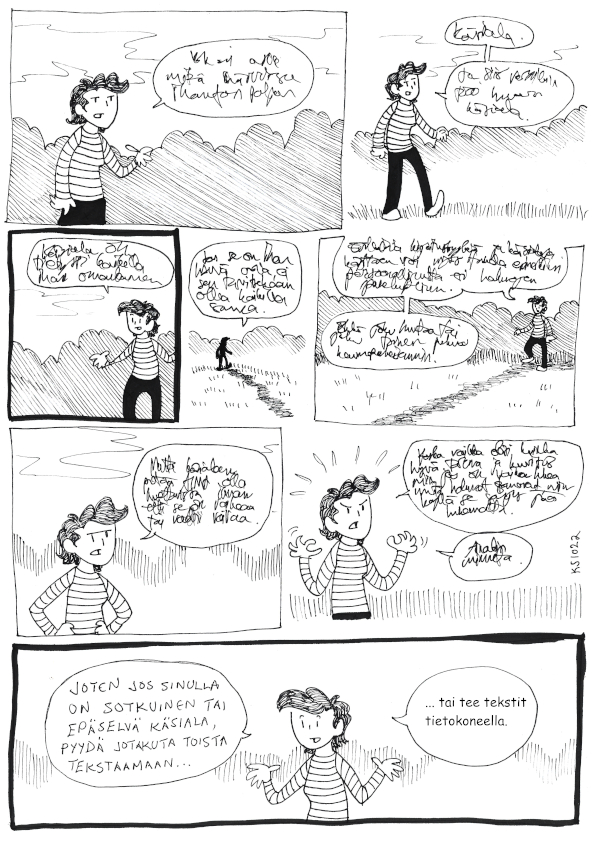
(Illegible handwriting)
”So if your handwriting is messy or unreadable, ask someone else to letter your comics… or do it by computer.”
Jos et jaksanut lukea sotkujani, niin näin siinä lukee:
”Yksi asia, mikä häiritsee ihan tosi paljon.” //
”Käsiala. Ja siis varsinkin tosi huono käsiala.” //
”Käsiala on tietysti kaikilla ihan omanlainen.” //
”Ja se on ihan hyvä asia, ei sen tarvitsekaan olla kaikilla sama.” //
”Erilaisia kirjoitustyylejä ja käsialoja käyttäen voi myös tuoda esimerkiksi persoonallisuutta eri hahmojen puhekupliin. Ehkä joku huutaa tai joku toinen puhuu kaunopuheisemmin.” //
”Mutta käsialan pitää AINA olla luettavissa ilman että se on vaikeaa tai vaatii vaivaa.” //
”Koska vaikka olisi kuinka hyvä tarina ja kuvitus, niin jos on vaikea lukea, mitä hahmot sanovat, niin kyllä se sarjis jää lukematta. Ainakin minulta.”
Here’s what’s written in that terrible handwriting:
”One thing that really annoys me.” //
”Handwriting. And I mean bad handwriting.” //
”Everyone of course has their own style of writing by hand.” //
”And that’s a good thing, not everyone’s handwriting has to be the same.” //
”By using different types of writing and lettering you can, for example, also bring personality to different characters’ speech bubbles. Maybe someone is shouting and someone else is more eloquent.” //
”But handwriting must ALWAYS be legible without it being hard or taking too much effort.” //
”Because even if the story and the drawings are really good, if the text is difficult to read, then the reader is not going to read it. At least I won’t.”
PS. Kiitos äidilleni viimeisen ruudun puhekuplan tekstaamisesta.
PS. Thanks to my mom for lettering the speech bubble in the last panel.
PPS. Tottakai se on Comic Sans, mitä muutakaan odotitte?
PPS. Of course it’s Comic Sans, what were you expecting?
SJEP: Intro
CTID: INTRO

”Hello everyone!” //
”This post is the first in a little longer series of comics. Its name is ’Comic things I dislike’.” //
”Its original name was ’Comic things I hate” but ’hate’ is too strong a word for these comics, and too absolute.” //
”I’m planning to tell about thing in comics, mostly in the comic style, that I dislike or find irritating.” //
”I also want to say that I am not a professional in comics but these are the opinions of an amateur. Also, all comic makers have their own style, and some use the things that I normally dislike really well!” //
”And indeed, these are my OPINIONS. Everyone can like exactly the comics they like – or not like!” //
”And yes, over the years I have fallen ’guilty’ of probably all the things I’m going to talk about.” //
”So I hope you don’t take this too seriously. I don’t want to insult anyone, I just want to talk about comics! We’ll start in the next post!”
Ole se fanitaide, jonka haluat nähdä maailmassa
BE THE FAN ART YOU WANT TO SEE IN THE WORLD
Toimin vaihteeksi pelinjohtajana ja laitoin Sankariakatemia-roolipelin hahmot muuttumaan lapsiksi ja joutumaan peitehommiin kesäleirille! Kun sanoin, että tästä olisi hauska nähdä fanitaidetta, yksi pelaajista vastasi, että ”ole se fanitaide, jonka haluat nähdä maailmassa”. Niinpä piirsin itse. Tosin yli puolet pelaajista taisi pelin aikana piirtää hahmonsa lapsina.
I was acting as the game master for a change and I made the characters from the Hero Academy RPG turn into children and having to work undercover on a summer camp! When I said I would like to see fan art of this, one of my players answered that I have to ”be the fan art you want to see in the world”. So I drew it myself. Though more than half of the players drew their characters as children during the game.
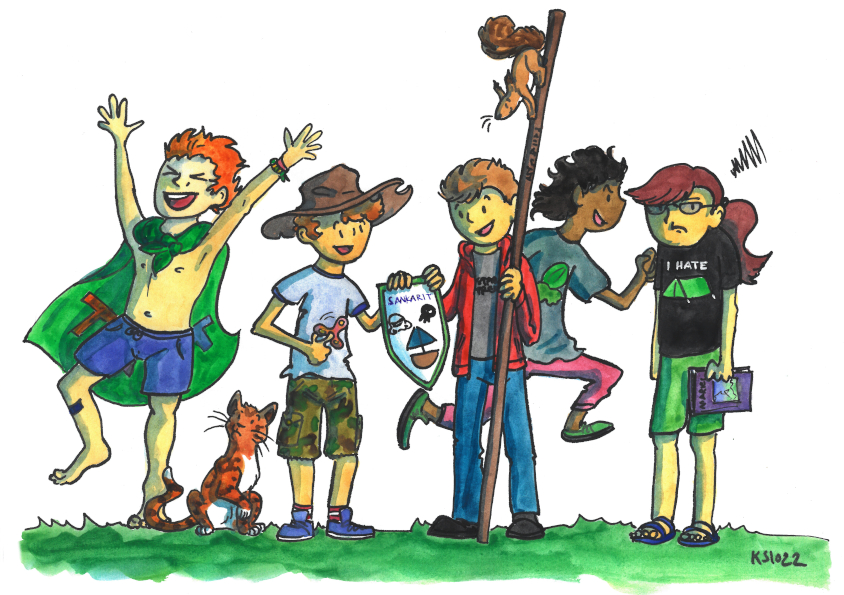
Hahmoilla oli kovin erilaiset tavat suhtautua lapsena oloon. Andreaksella oli parasta ikinä ja hän teki pyyhkeestä viitan ja juoksi ympyrää. Minun hahmoni Thranon piti muuttaa kissaksi, hän söi myyriä metsässä. John-Joseph tykkäsi fidget spinneristä ja lapsena olosta niin, että hän päätti jäädä lapseksi pelin lopussa. Terry vaati saada ottaa Boromirilta saamansa vaellussauvan mukaan leirille. Alienorava Onni muutettiin taas tavalliseksi oravaksi, joka ei saanut käyttää kirvestä. Minuel ei tällä kertaa ampunut, kun kesäleirille ei saanut tuoda jousta, mutta Minuel juoksi senkin edestä. Tea mökötti koko ajan.
The characters had very different attitudes towards being kids again. Andreas was having the time of his life, he made a towel cape and ran around in circles. My character Thranon was turned into a cat, she was eating voles in the woods. John-Joseph liked having a fidget spinner and being a child so much that he chose to remain a child after the adventure. Terry demanded that he wanted to take the hiking staff he got from Boromir to the camp. The alien squirrel Onni was turned into a regular squirrel that wasn’t allowed to use an ax. Minuel didn’t shoot this time as she couldn’t take her bow to the camp but she made up for it by running a lot. Tea was sulking all the time.
Tarinassa esiintyi myös kissaihmisten kuningas Rasmus, jolla on mukanaan kaikenlaista leiriläisten ja ohjaajien vuosien varrella kadottamaa kamaa. Kuvauksistani jotkut pelaajat päättelivät kohdanneensa jonkinlaisen Muumien Piisamirotan eivätkä suinkaan kissaihmistä, mutta se oli ihan hyvä juttu. Tältä ajattelin Rasmuksen suunnilleen näyttäneen. (Kissaihmisillä ei minun mielestäni ole häntää, hehän ovat olleet ihmisiä aivan hiljattain.)
One of the characters in the story was the cat people’s king Rasmus who was wearing all sorts of stuff that camp kids and instructors have lost over the years. From my descriptions some players thought he was more like some Moomin character and not a cat person but that actually was a good thing. However, this is what I thought Rasmus looked like. (I don’t think cat people have tails as they were humans not that long ago.)
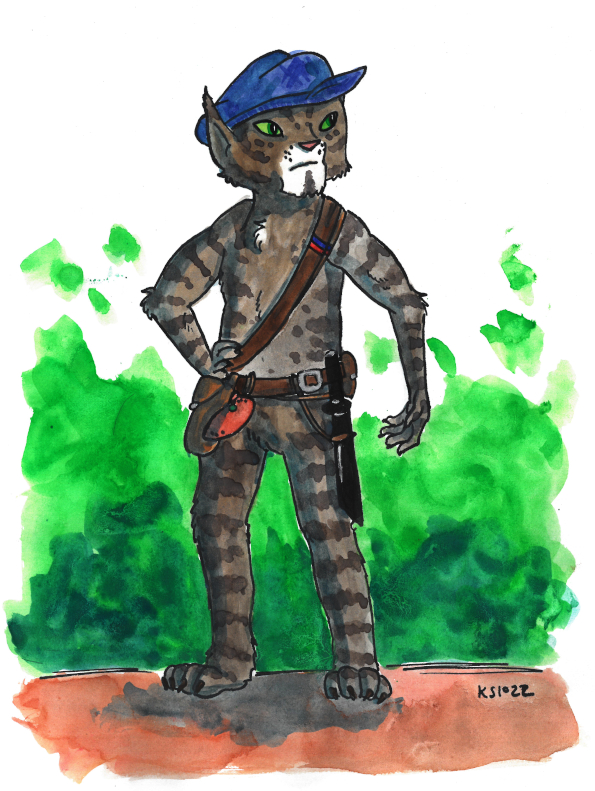
Mulla oli aivan liian hauskaa vetää tätä peliä.
I had way too much fun GMing this game.
Keskipakoisvoimaa ei ole olemassa
THERE IS NO SUCH THING AS CENTRIFUGAL FORCE…
…mutta sitä voi silti hyödyntää.
…but you can still take advantage of it.
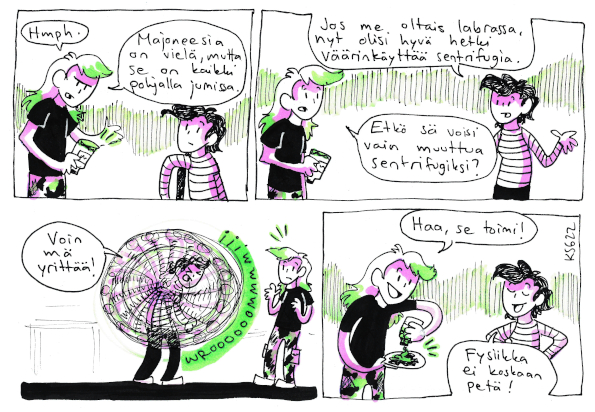
”Hmph. There’s still mayonnaise in this bottle but it’s all stuck in the bottom.” //
”If we were in a lab, this would be a really good time to abuse a centrifuge.” ”Couldn’t you just turn yourself into one?” //
”I can try!” //
”Ha, it worked!” ”Physics never let you down!”
Palikka
Kuningas
KING
Lukioaikoina piirtelin paljon aarnikotkia. Se harrastus on vähän jäänyt, mutta aina välillä tekee mieli palata vanhoihin hyviin aikoihin. Tässä siis Tuhkasiipi, ja otsikosta voi päätellä, että hän on yksi aarnikotkien kuninkaista.
In high school I used to draw lots of griffins. I haven’t really done that lately but every so often I feel like picking up those old hobbies. So here’s Ashwing, and as you can deduce from the title, he’s one of the kings of the griffins.
